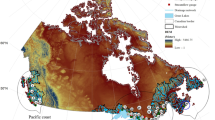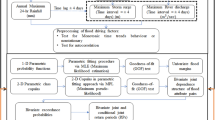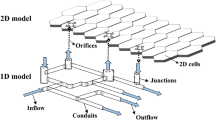Abstract
Rainfall and storm tides are both flood drivers in coastal zones. The complex interplay between them can lead to or exacerbate the impacts of flooding. While the dependence between rainfall and storm tides has been extensively studied, the compound effects of them on coastal flood risk have not been well researched. With Haikou city as the case study, this study investigates the bivariate return period of compounding rainfall and storm tide events based on copula functions and the failure probability is used to assess the variation of bivariate flood risk during the entire project lifetime. The results show that (1) there is a significant correlation between rainfall and storm tides. Therefore, bivariate RP analysis can provide more adequate and comprehensive information about risks than univariate RP analysis. Kendall RP can describe the bivariate RP more accurately since the dangerous region of Kendall RP is divided by the joint probability value. (2) Neglecting the compounding impacts and the dependence of rainfall and storm tides causes significant underestimation of the joint RP and failure probability. (3) The bivariate hydrologic risk value will decrease quickly when the design rainfall is higher than 100 mm and it becomes small and decrease slowly when the design rainfall exceeds 450 mm. Furthermore, the bivariate hydrologic risk value would not decrease until the storm tide is higher than 2 m and the values would become quite small as the storm tide exceeds 4.5 m. Such bivariate hydrologic risk analysis can provide decision support for hydraulic facility design as well as actual flood control and mitigation.












Similar content being viewed by others
References
Abdi A, Hassanzadeh Y, Talatahari S, Fakheri-Fard A, Mirabbasi R (2016) Regional bivariate modeling of droughts using L-comoments and copulas. Stoch Environ Res Risk Assess 31(5):1199–1210
Almeida CT, Oliveira-Júnior JF, Delgado RC, Cubo P, Ramos MC (2017) Spatiotemporal rainfall and temperature trends throughout the Brazilian legal amazon, 1973–2013. Int J Climatol 37:2013–2026
Ampitiyawatta AD, Guo S (2009) Precipitation trends in the Kalu Ganga basin in Sri Lanka. J Agric Sci 4(1):10–18
Archetti R, Bolognesi A, Casadio A, Maglionico M (2011) Development of flood probability charts for urban drainage network in coastal areas through a simplified joint assessment approach. Hydrol Earth Syst Sci 15(10):3115–3122
Awan JA, Bae D, Kim K (2015) Identification and trend analysis of homogeneous rainfall zones over the East Asia monsoon region. Int J Climatol 35(7):1422–1433
Bisht DS, Chatterjee C, Raghuwanshi NS, Sridhar V (2017) Spatio-temporal trends of rainfall across Indian River basins. Theor Appl Climatol 80:1–18
Chebana F, Dabo N, Ouarda T (2012) Exploratory functional flood frequency analysis and outlier detection. Water Resour Res 48:W04514
Chen Z, Qiang H, Liu Z (2016) Risk assessment of trivariate flood based on asymmetric Archimedean copulas. Advances in Water Science 26(5):763–771
Coles SG, Heffernan J, Tawn JA (1999) Dependence measures for extreme value analysis. Extremes 2:339–365
Eric G, Valerie B, Pietro B (2009) A compilation of data on European flash floods. J Hydrol 367:70–78
Genest C, Quessy JF, Rémillard B (2006) Goodness-of-fit procedures for Copula models based on the probability integral transformation. Scand J Stat 33(2):337–366
Guo A, Chang J, Wang Y, Huang Q, Guo Z, Zhou S (2017) Bivariate frequency analysis of flood and extreme precipitation under changing environment: case study in catchments of the Loess Plateau. China. Stoch Environ Res Risk Assess 32(7):2057–2074
Hallegatte S, Green C, Nicholls RJ, Corfee-Morlot J (2013) Future flood losses in major coastal cities. Nat Clim Change 3(9):802–806
Haylock M, Nicholls N (2015) Trends in extreme rainfall indices for an updated high quality data set for Australia, 1910–1998. Int J Climatol 20(13):1533–1541
Huang Q, Chen Z (2015) Multivariate flood risk assessment based on the secondary return period. J Lake Sci 27(2):352–360
Karmakar S, Simonovic S (2009) Bivariate flood frequency analysis. J Flood Risk Manag 2(1):32–44
Kumar V, Jain Sharad K, Singh Y (2010) Analysis of long-term rainfall trends in India. Hydrol Sci J 55(4):484–496
Leonard M, Metcalfe A, Lambert M (2008) Frequency analysis of rainfall and streamflow extremes accounting for seasonal and climatic partitions. J Hydrol 348(1):135–147
Li F, Zheng Q (2016) Probabilistic modelling of flood events using the entropy copula. Adv Water Resour 97:233–240
Li W, Xu B, Wen J (2016) Scenario-based community flood risk assessment: a case study of Taining county town, Fujian Province, China. Nat Hazards 82(1):193–208
Lian J, Xu K, Ma C (2013) Joint impact of rainfall and tidal level on flood risk in a coastal city with a complex river network: a case study of Fuzhou City, China. Hydrol Earth Syst Sci 17(2):679–689
Lian J, Xu H, Xu K, Ma C (2017) Optimal management of the flooding risk caused by the joint occurrence of extreme rainfall and high tide level in a coastal city. Nat Hazards 89(1):183–200
Malmgren B, Hulugalla Ranatunge A, Hayashi Y, Mikami T (2003) Precipitation trends in Sri Lanka since the 1870’s and relationship to El Nino-Southern Oscillation. Int J Climatol 23:1235–1252
Mayowa OO, Pour SH, Shahid S, Mohsenipour M, Harun SB, Heryansyah A et al (2015) Trends in rainfall and rainfall-related extremes in the east coast of peninsular Malaysia. J Earth Syst Sci 124(8):1609–1622
Milly PCD, Wetherald RT, Dunne KA, Delworth TL (2002) Increasing risk of great floods in a changing climate. Nature 415(6871):514–517
Mirakbari M, Ganji A, Fallah S (2010) Regional bivariate frequency analysis of meteorological droughts. J Hydrol Eng 15:985–1000
Moftakhari HR, Salvadori G, Aghakouchak A et al (2017) Compounding effects of sea level rise and fluvial flooding. Proc Natl Acad Sci USA 114(37):9785
Mondal A, Khare D, Kundu S (2015) Spatial and temporal analysis of rainfall and temperature trend of India. Theor Appl Climatol 122(1–2):143–158
Naidu CV, Raju AD, Satyanarayana GC, Chiranjeevi G, Suchitra P (2015) An observational evidence of decrease in Indian summer monsoon rainfall in the recent three decades of global warming era. Glob Planet Change 127:91–102
Read LK, Vogel RM (2015) Reliability, return periods, and risk under nonstationarity. Water Resour Res 51(8):6381–6398
Salvadori G, Michele CD (2010) Multivariate multiparameter extreme value models and return periods: a copula approach. Water Resour Res 46(10):219–233
Salvadori G, Michele CD, Durante F (2011) On the return period and design in a multivariate framework. Hydrol Earth Syst Sci 15(11):3293–3305
Salvadori G, Durante F, De Michele C et al (2016) A multivariate Copula-based framework for dealing with hazard scenarios and failure probabilities. Water Resour Res 52(5):3701–3721
Serinaldi F (2009) Copula-based mixed models for bivariate rainfall data: an empirical study in regression perspective. Stoch Environ Res Risk Assess 23(5):695–696
Serinaldi F (2015) Dismissing return periods! Stoch Environ Res Risk Assess 29(4):1179–1189
Stefanidis S, Stathis DR (2013) Assessment of flood hazard based on natural and anthropogenic factors using analytic hierarchy process (AHP). Nat Hazards 68:569–585
Svensson C, Jones DA (2004) Dependence between sea surge, river flow and precipitation in south and west Britain. Hydrol Earth Syst Sci 8(5):973–992
Syafrina AH, Zalina MD, Juneng L (2015) Historical trend of hourly extreme rainfall in peninsular Malaysia. Theor Appl Climatol 120(1–2):259–285
Vallebona C, Pellegrino E, Frumento P, Bonari E (2015) Temporal trends in extreme rainfall intensity and erosivity in the Mediterranean region: a case study in southern Tuscany, Italy. Clim Change 128(1–2):139–151
van den Hurk B, Meijgaard EV, Valk PD et al (2015) Analysis of a compounding surge and precipitation event in the Netherlands. Environ Res Lett 10(3):035001
Wahl T, Jain S, Bender J et al (2015) Increasing risk of compound flooding from storm surge and rainfall for major US cities. Nat Clim Change 22:1–2. https://doi.org/10.1038/nclimate2736
Wang C, Chang N, Yeh G (2009) Copula-based flood frequency (COFF) analysis at the confluences of river systems. Hydrol Proces 23:1471–1486
Wang Y, Li C, Liu J, Yu F, Qiu Q, Tian J (2017) Multivariate analysis of joint probability of different rainfall frequencies based on copulas. Water 9:198
Wickramagamage P (2015) Spatial and temporal variation of rainfall trends of Sri Lanka. Theor Appl Climatol 125:427–438
Wilby RL, Beven KJ, Reynard NS (2008) Climate change and fluvial flood risk in the UK: more of the same? Hydrol Process 22(14):2511–2523
Woodruff JD, Irish JL, Camargo SJ (2013) Coastal flooding by tropical cyclones and sea-level rise. Nature 504(7478):44–52
Xu K, Ma C, Lian J, Bin L (2014) Joint probability analysis of extreme precipitation and storm tide in a coastal city under changing environment. PLoS ONE 9(10):e109341–e109341
Xu K, Yang D, Xu X, Lei H (2015) Copula based drought frequency analysis considering the spatio-temporal variability in Southwest China. J Hydrol 527:630–640
Xu Y, Huang G, Fan Y (2017) Multivariate flood risk analysis for Wei River. Stoch Environ Res Risk Assess 31:225–242
Yilmaz AG, Perera BJC (2015) Spatiotemporal trend analysis of extreme rainfall events in Victoria, Australia. Water Resour Manag 29(12):4465–4480
Zhang Q, Singh V, Li J, Jiang F, Bai Y (2012) Spatio-temporal variations of precipitation extremes in Xinjiang, China. J Hydrol 434–435:7–18
Zhang Q, Xiao M, Singh VP, Chen X (2013) Copula-based risk evaluation of hydrological droughts in the east river basin, China. Stoch Environ Res Risk Assess 27(6):1397–1406
Zheng F, Westra S, Sisson SA (2013) Quantifying the dependence between extreme rainfall and storm surge in the coastal zone. J Hydrol 505(21):172–187
Zheng F, Seth W, Michael L, Sisson SA (2014) Modeling dependence between extreme rainfall and storm surge to estimate coastal flooding risk. Water Resour Res 50(3):2050–2071
Acknowledgements
The research was supported by National Key Research and Development Program of China (2016YFC0401903), National Natural Science Foundation of China (51509179, 51679159), the Science Fund for Creative Research Groups of the National Natural Science Foundation of China (51621092), the Program of Introducing Talents of Discipline to Universities (B14012), the Tianjin Research Program of Application Foundation and Advanced Technology (15JCYBTC21800). The authors acknowledge the assistance of anonymous reviewers.
Author information
Authors and Affiliations
Corresponding author
Additional information
Publisher's Note
Springer Nature remains neutral with regard to jurisdictional claims in published maps and institutional affiliations.
Rights and permissions
About this article
Cite this article
Xu, H., Xu, K., Lian, J. et al. Compound effects of rainfall and storm tides on coastal flooding risk. Stoch Environ Res Risk Assess 33, 1249–1261 (2019). https://doi.org/10.1007/s00477-019-01695-x
Published:
Issue Date:
DOI: https://doi.org/10.1007/s00477-019-01695-x




